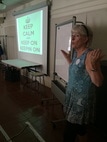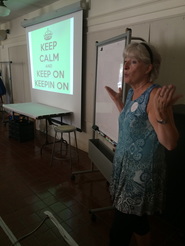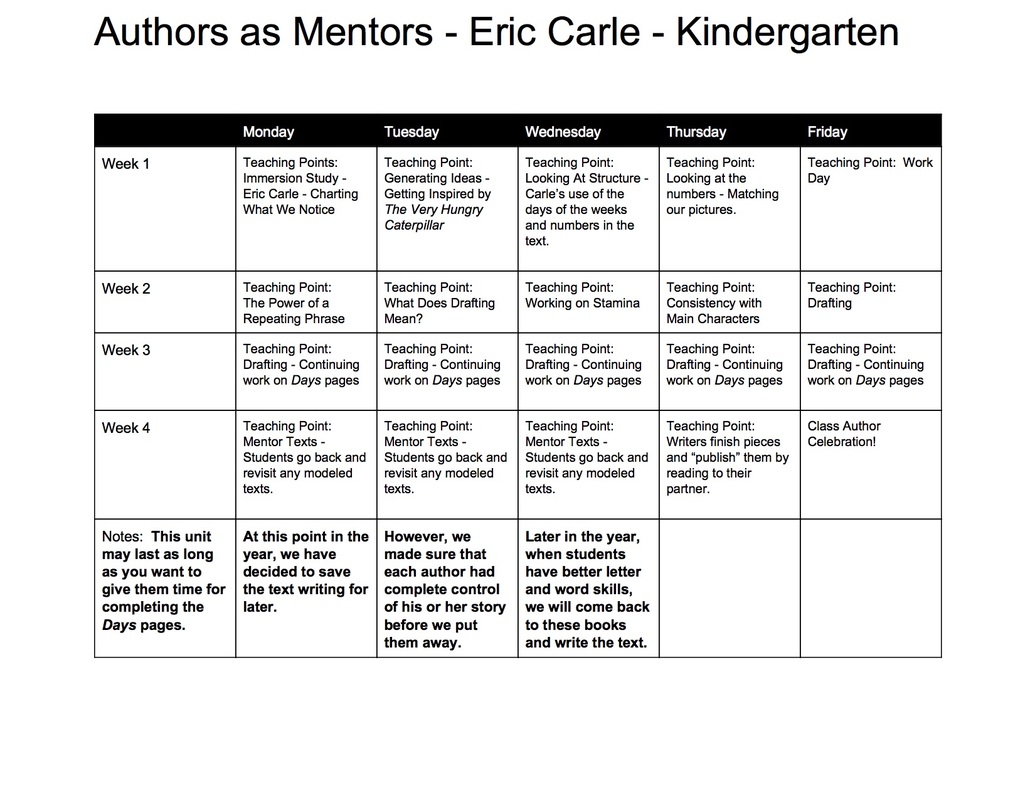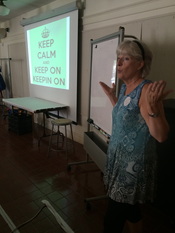
"Nobody makes a greater mistake than he who does nothing because he could only do a little." - Edmund Burke.
And isn't that the way we often feel when we teach writing to young students? That we can "only do a little"? Our work with them in the precious year we have together seems so fleeting. How can we possibly have made a difference in their writing lives when they leave our classrooms in June?
We do make a difference when we teach writers and not writing. When our focus is on helping the writers sitting in our rooms develop habits of mind that are sustainable beyond our doorways, we are extending the influence of our teaching beyond the moment. I had a personal reminder of the importance of valuing small influences this week.
As writing teachers, we must firmly and with clear vision understand the impact of our time with our students. We may "only have a year" with these writers. Or, we may "have a whole year" with these writers!! It depends on your perspective. I say embrace every bit of the teaching time you have with your writers. In the scope of their learning lives, it may seem like "a little". But some piece of your instruction may, in fact, change the way they think about writing for the rest of their lives!
This week in kindergarten, we began our eighth unit of study - "All About" Books. One of the most important goals of a coach, whether coaching a student or a colleague, is the gradual release of responsibility. My colleague, the teacher who welcomed me as a coach into her room last September, has taken on the role of principal planner for this unit. She and I have worked so well together this year; our collaboration has been full of great discussion and side-by-side teaching. She had a vision of moving our students into a nonfiction writing project, and her vision is defining the unit.
Our first objective was to expose the students to the idea of doing research. They will be writing a book about rhinos as we teach the mode of writing to inform. The teacher's first lesson was centered around using an online site to do research. Here is her plan:
Lesson Objective: Students will learn how to use an online site to find fun facts (research) for their "All About" book topics.
Materials: Classroom projector
Online database or research site
Chart
Markers
Connect: Tell students that today we are starting a new project. Remind them that they have been working on telling stories from their own lives using pictures and words in their journals. That is called narrative writing. Today, they are going to learn to write about “true” things. That is called informational writing. Say, “We are going to do ‘research’. Does anyone know what that means?’ Wait for answers. Then add, ‘Research means you find information about something so that you can write about it for a reader.’”
Teach: Today we are going to learn about rhinos! That will be the topic for our very first "All About" book. Does anyone know anything about rhinos?
Make a chart of any ideas the children have about rhinos. (They are big. They have big bodies. They like mud. They like to run fast.)
Tell the students that some of what they think may be true, some may not. Tell them that we will do research to find out. Discuss with the students that not everything you read on the internet may be true. It is important to use only those sites that have good information.
Go to the site you have chosen.
On the first site we chose, we noticed there were different categories about the rhino - Habitat, Body, Life Cycle, Food, Fun Facts, Related Articles.
Depending on the amount of time you have, decide how many categories to explore in a session. We guided the students through each one, listening to text read aloud, clicking on highlighted keywords, and discussing the content.
Active Engagement: After exploring the site for as much time as you decide, lead the class in a discussion of what was learned. Write the information on chart paper. You will find that they remember the information that was most appealing to them!
Example:
All About Rhinos
Link: Read over the facts that the students have learned from using the online site. Remind them that online databases help you find out what is important about a nonfiction topic when you are doing research.
We will spend additional time looking at online sites and adding to our chart. Next, we will begin working with the idea of organizing our information for our readers.
As I watch my colleague working on this unit of study, I remember that I will not be in her classroom next year. And I wonder if we have had enough time together for my coaching to have been of lasting value to her.
In the end, it may have been "just a little". But, it also might have been just enough!
Do all that you can for your writers. We may never know the true scope of our influence. But we will always know that we taught them what we could in the time we had with them.
#allkidscanwrite
and
#allteacherscanteach
Have a great writing week!
And isn't that the way we often feel when we teach writing to young students? That we can "only do a little"? Our work with them in the precious year we have together seems so fleeting. How can we possibly have made a difference in their writing lives when they leave our classrooms in June?
We do make a difference when we teach writers and not writing. When our focus is on helping the writers sitting in our rooms develop habits of mind that are sustainable beyond our doorways, we are extending the influence of our teaching beyond the moment. I had a personal reminder of the importance of valuing small influences this week.
As writing teachers, we must firmly and with clear vision understand the impact of our time with our students. We may "only have a year" with these writers. Or, we may "have a whole year" with these writers!! It depends on your perspective. I say embrace every bit of the teaching time you have with your writers. In the scope of their learning lives, it may seem like "a little". But some piece of your instruction may, in fact, change the way they think about writing for the rest of their lives!
This week in kindergarten, we began our eighth unit of study - "All About" Books. One of the most important goals of a coach, whether coaching a student or a colleague, is the gradual release of responsibility. My colleague, the teacher who welcomed me as a coach into her room last September, has taken on the role of principal planner for this unit. She and I have worked so well together this year; our collaboration has been full of great discussion and side-by-side teaching. She had a vision of moving our students into a nonfiction writing project, and her vision is defining the unit.
Our first objective was to expose the students to the idea of doing research. They will be writing a book about rhinos as we teach the mode of writing to inform. The teacher's first lesson was centered around using an online site to do research. Here is her plan:
Lesson Objective: Students will learn how to use an online site to find fun facts (research) for their "All About" book topics.
Materials: Classroom projector
Online database or research site
Chart
Markers
Connect: Tell students that today we are starting a new project. Remind them that they have been working on telling stories from their own lives using pictures and words in their journals. That is called narrative writing. Today, they are going to learn to write about “true” things. That is called informational writing. Say, “We are going to do ‘research’. Does anyone know what that means?’ Wait for answers. Then add, ‘Research means you find information about something so that you can write about it for a reader.’”
Teach: Today we are going to learn about rhinos! That will be the topic for our very first "All About" book. Does anyone know anything about rhinos?
Make a chart of any ideas the children have about rhinos. (They are big. They have big bodies. They like mud. They like to run fast.)
Tell the students that some of what they think may be true, some may not. Tell them that we will do research to find out. Discuss with the students that not everything you read on the internet may be true. It is important to use only those sites that have good information.
Go to the site you have chosen.
On the first site we chose, we noticed there were different categories about the rhino - Habitat, Body, Life Cycle, Food, Fun Facts, Related Articles.
Depending on the amount of time you have, decide how many categories to explore in a session. We guided the students through each one, listening to text read aloud, clicking on highlighted keywords, and discussing the content.
Active Engagement: After exploring the site for as much time as you decide, lead the class in a discussion of what was learned. Write the information on chart paper. You will find that they remember the information that was most appealing to them!
Example:
All About Rhinos
- They weigh 5,000 lbs.
- They have one or two horns.
- They are endangered.
- They eat 30-60 lbs of food every day.
- They are mammals (mommies feed their babies milk; hair or fur on their bodies; warm-blooded; breathe air)
- Their habitat is the grasslands (African savannah or in India).
- They eat grass and leaves.
Link: Read over the facts that the students have learned from using the online site. Remind them that online databases help you find out what is important about a nonfiction topic when you are doing research.
We will spend additional time looking at online sites and adding to our chart. Next, we will begin working with the idea of organizing our information for our readers.
As I watch my colleague working on this unit of study, I remember that I will not be in her classroom next year. And I wonder if we have had enough time together for my coaching to have been of lasting value to her.
In the end, it may have been "just a little". But, it also might have been just enough!
Do all that you can for your writers. We may never know the true scope of our influence. But we will always know that we taught them what we could in the time we had with them.
#allkidscanwrite
and
#allteacherscanteach
Have a great writing week!



 RSS Feed
RSS Feed
